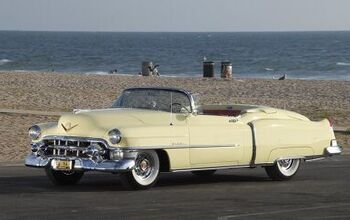Alles Gute Zum Geburtstag, Autobahn!
Germany's famed Autobahn turns 75 today. Deutsche Welle recalls how the first 20-kilometer stretch between Cologne and Bonn was opened to the public on August 6, 1932. The new highway had some very specific rules, many of which still apply. The Kölnische Zeitung newspaper wrote on Aug. 5, 1932: "Due to a specific police order, every other traffic, such as pedestrians, carts, bicyclists, motorcyclists and horse carriage, is prohibited to drive on the street." Today, the Autobahn stretches 12,400km. Despite the widespread belief that you can drive on the autobahn as fast as you dare, most sections have posted speed limits. As for the "de-restricted" segments, environmental groups have been calling for the imposition of speed limits since the '60's. Thanks to global wamring concerns, those voices have gathered new strength. Despite the country's cultural attachment to "fun, fun, fun on the autobahn," it's only a matter of time before the adrenal anachronism is "harmonized" with European law.
More by Frank Williams


































Comments
Join the conversation
Another thing - on many sections, they use dynamic speed signs; small cameras check how many cars are on the road, and they change the speed limit if deemed necessary. So, if there is a lot of traffic, the limit may be lowered to 120 kph or even lower; but at night or on weekends, it's derestricted. And the signs also warn you if there's been an accident ahead and such - pretty neat, if you ask me.
A BMW PR guy said to me--and this was way back in the late '70s--"Honda's engineers come to work on the tube. Our engineers come to work on the Autobahn." The Autobahn network has a huge amount to do with why German cars are the way they are. I remember coming over a rise on a quite wide, often busy stretch of the Autobahn approaching Frankfurt from Stuttgart, as I remember, and it suddenly looked like the touchdown zone of a JFK runway: black streaks for a thousand feet, everywhere. It apparently was a classic place for rush-hour traffic backups, and they were unexpected until drivers got over the rise. somebody told me that very specific stretch of Autobahn had a lot to do with the Germans developing automotive ABS (which was actually developed years earlier by Dunlop, for aircraft use). I've driven a fair amount on Autobahns, at least for an American, and it's an interesting experience. I remember a time when you had to be super-careful of gastarbeiters--guestworkers, often Turkish or Portuguese (we'd call them migrant laborers...) who typically were driving old Fiat 500s or the like. You'd come steaming up the left lane at 150 or more and they'd pull out not far in front of you to pass a truck, doing their best to accelerate to 70...
Luther, I think the level of driver training works not so much because of the skills, but because of the overall attitude to driving that exists in a country that requires such extensive training. Obviously in most European countries driving is seen as a privelege, not the right that people seem to think it is on this side of the pond.
tech98 - the northern territory is unrestricted no more "Driving in the Northern Territory will never be the same after Clare Martin's Labor Government announced today that speed limits will be imposed on Territory highways for the first time. A sad day for some, but not for many others. Right now it's open slather on open roads. The Chief Minister says driving habits in the Territory are appalling, even in town areas where speed limits do prevail. Repeat offending is rife. One motorist, for instance, copped 47 speeding fines over three years but like all offenders, he kept his licence because the Territory still doesn't have a demerit point system. The Territory traffic laws will now be brought into line with the rest of the country, although as a gesture to long distance drivers the new speed limit on major highways will be 130km/h." Speed limits in Australia are generally low and are enforced. The traffic on city freeways really does travel at or close to the limit of 100 (or 110) km/h. The extent to which speed limits are ignored in Australia's vast rural and arid areas is hard to estimate. It seems to me that those areas are very much over-represented in traffic accident statistics. Whether this is due to excessive speed or inattention (in both cases having regard to the condition of the car and the road)I don't know - but my guess is that its a bit of everything. The reality is that road travel can be hazardous to your health whatever the rules. All societies with substantial road traffic tolerate a level of road trauma that's hard to imagine would be permitted to continue if it was by any other cause (say, for example, death by electrocution).